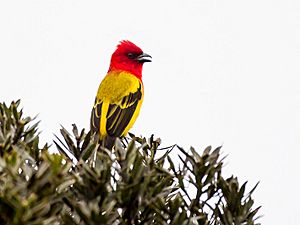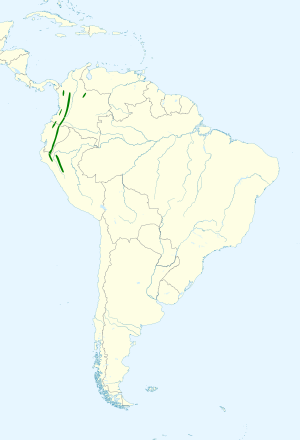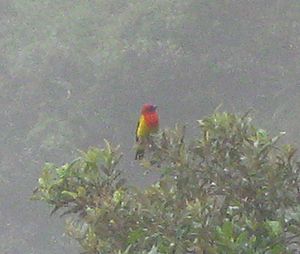Red-hooded tanager facts for kids
Quick facts for kids Red-hooded tanager |
|
|---|---|
 |
|
| Conservation status | |
| Scientific classification | |
| Genus: |
Piranga
|
| Species: |
rubriceps
|
 |
|
The red-hooded tanager (Piranga rubriceps) is a colorful songbird found in parts of South America. It is a medium-sized bird that belongs to the Cardinalidae family. This family includes cardinals and grosbeaks. You can find red-hooded tanagers living in the countries of Colombia, Ecuador, and Peru.
Contents
About the Red-hooded Tanager
Bird Families: Where Does it Belong?
The red-hooded tanager and other birds in its group, called Piranga, used to be part of a different bird family. They were once thought to be "true" tanagers in the Thraupidae family. However, around 2008, scientists learned more about these birds. They decided to move them to their current family, the Cardinalidae. This family includes birds like cardinals and grosbeaks. The red-hooded tanager is the only bird of its kind, meaning it is a "monotypic" species.
What Does the Red-hooded Tanager Look Like?
This bird is about 17 centimeters (6.7 inches) long. It weighs between 28 and 42 grams (about 1 to 1.5 ounces).
Male red-hooded tanagers are mostly yellow. They have a bright red "hood" that covers their head and goes down to their chest. Female birds look similar to the males. However, their colors are not as bright. Also, the red on their head does not reach their chest.
Where Do Red-hooded Tanagers Live?
Red-hooded tanagers live in the Andes mountains of South America. You can find them in the western, central, and eastern parts of Colombia. They also live on the eastern side of the Andes, stretching south through Ecuador into Peru's Huánuco Province.
These birds prefer to live inside or at the edges of humid mountain forests. They especially like forests that have a lot of moss and plants growing on other plants (called epiphytes). In Colombia, they live at heights from 1,700 to 3,000 meters (about 5,600 to 9,800 feet) above sea level. In Ecuador, they are mostly found between 2,200 and 3,000 meters (about 7,200 to 9,800 feet). In Peru, their home is usually from 1,800 to 3,000 meters (about 5,900 to 9,800 feet) high.
Red-hooded Tanager Behavior
How Do They Find Food?
Red-hooded tanagers look for food by hopping through branches and leaves. They usually search in the middle and upper parts of the forest. Sometimes, they even forage out in the open. These birds often travel in pairs or small groups. About half the time, they join other bird species to look for food together. This is called a mixed-species foraging flock.
Reproduction and Life Cycle
Scientists have observed a female red-hooded tanager in Colombia's Western Andes that was ready to lay eggs in September. However, there is not much other information published about how these birds breed or their full life cycle.
What Do Red-hooded Tanagers Sound Like?
The song of the red-hooded tanager is a mix of thin trills, like "tititititi." It also includes sweeter, more musical sounds such as "tswe, weéteetseet-see" [1]. Another one of their songs sounds like "tsee-ee-ee-ee" [2]. Their calls include short notes like "spink!" and "tink!" [3].
See also
 In Spanish: Quitrique de capucha roja para niños
In Spanish: Quitrique de capucha roja para niños



